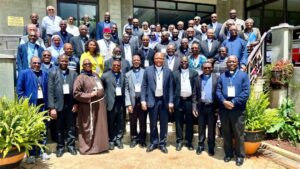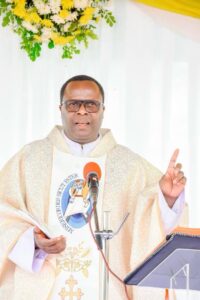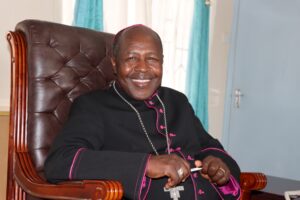KENYA: “What Inspired my Coat of Arms is a Call to Service,” Bishop-elect of Kenya’s Nakuru Diocese

Sr. Jecinter Antoinette Okoth, FSSA
Monsignor Cleophas Oseso Tuka, the Bishop-elect of Kenya’s Nakuru Diocese has disclosed that the inspiration behind his Coat of Arms is on Christ’s teaching which emphasizes on service to humanity.
Even if one is called to the rank of a Bishop, Msgr. Oseso shared with AMECEA Online in an interview few days to his Episcopal Ordination, “It is still a continuation of the ministry of priesthood which is a call to service for the people of God not only in the parish but the entire Diocese.”
In his Coat of Arms, Msgr. Oseso who is to be ordained on Saturday, May 6, as the fourth Bishop of Nakuru, one of the Suffragan Dioceses of Nairobi Archdiocese, has used various symbols to illustrate the aspect of service including; the icon on washing of feet, host, chalice and paschal candle, Dove and seven rays, African calabash and Sacred Heart.
Expounding on these symbols, Msgr. Oseso who till his appointment was the Vicar General of Nakuru Diocese and Father in Charge of Bahati Parish said; “In washing the feet of his disciples, Jesus shows what great humility and sacrificial love looks like. It is a reminder that the priesthood is not a career, but rather a service, to wash one another’s feet.”
For the dove and the rays, he said, “The dove symbolizes the presence of God through the Holy Spirit who constantly leads and guides the Church. The seven rays represent the seven spiritual gifts given by the Holy Spirit for the building up of the Church and for ministry in the world.”
He added that the Holy Spirit which was given at Pentecost for the growth, guidance and protection of the Church, will strengthen Nakuru Diocese in times of difficulty knowing that the far the Diocese has gone with its achievement is the work of the Holy Spirit.
Bishop-elect further expounded on the use of host, chalice and paschal candle in his Coat of Arms saying that, “In the Eucharist, we, the people of God, receive Jesus who loves us like no other and provides us with the essential nourishment so that we can grow in our spiritual life.” He acknowledged that the Eucharist is the center of Christian life “that is why we are invited to priestly life and called to feed, to teach and nurture souls.”
He continued, “The Paschal candle signifies the light of Christ in a world darkened by sin, and the warmth in a world that is too often cold and treating people heartlessly.”
The former financial administrator and parochial vicar in Rochester Diocese, New York, also used an icon of calabash a popular traditional African container embodiment of the African Culture which he says symbolizes; “sustenance, hospitality, fertility, abundance, and protection.”
“This signifies the invitation of the local church to use the resources available to her and invest internally for the future sustainability of her ministries,” he narrated and explained further during the interview on Monday, May 1, that “Being Africans there are some values we carry on even in our Christian life and which we need to treasure.”
With this backdrop, Bishop-elect emphasized that African Church is still growing and trying to find its footing, hence she is also being invited in the life of the whole Church “to come up with its own uniqueness to make the Church more vibrant, more sustaining and more self-supporting.”
The use of three images of calabashes in the Coat of Arms symbolize the Holy Trinity and the generosity of God the Father the Son and the Holy Spirit.
Subsequently, “The heart is the sign for love. The Sacred Heart image shows the heart as wounded, and this reminds us of the lance piercing the side of Christ on the cross,” Msgr. Oseso narrates the use of Sacred Heart in the Coat of Arms, and explains, “The crown of thorns reminds us that real love is faithful love, and total commitment which can lead at times to rejection and suffering.”
Talking about the cross which is right in the middle of the Coat of Arms, Msgr. Oseso stressed that the “cross is the primary symbol of Christian faith which draws us to contemplate the sacrificial love of Jesus, as he lays down his life for us on the cross.”
Bishop-elect whose motto is embedded in the Coat of Arms as “Per Caritatem Servite Invicem” (by love serve one another) as inspired by St. Paul’s letter to the Galatians, has further used different colors which he notes are in his Coat of Arms.
“Traditionally, the color of the Blessed Virgin Mary is blue, and in the Bible, it signifies service to God,” he said while shading light on the use of the blue color adding that, “This fits to describe the Blessed Virgin Mary as one who dedicates her life to serve God.”
White is the color of purity, joy, light, and glory he said, “This is what we Christians are called to bring into the world.” Additionally, “Radiance gold color represents glory and triumph, specifically Jesus’ resurrection and triumph over death, while green which the Catholic Church uses in the liturgy is a symbol of “hope, perseverance and continued listening. It also signifies life in nature and as such it represents growth, life and hope.”
To actualize his motto in the new ministry as the Local ordinary of the Diocese, Bishop-elect promises to implement participatory approach and engage other Christians in the diocese so that his plans and dream may come to life.
“The Church is a community of parishes and people. Since I will not be working alone I will involve the Religious, clergy and laity and together we will work towards achieving the goal of the diocese,” he said and continued, “In the participatory spirit, I look forward to actualizing the motto of the diocese.”
The Bishop-elect who was brought up in Nakuru Diocese but originally hails from the Archdiocese of Kisumu, Ukwala Parish, was appointed Bishop for Nakuru Diocese by Pope Francis on Wednesday, February 15.


